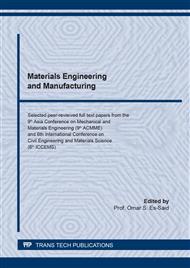[1]
Adekunle, T. O., & Odeyale, T. O. (2008). Innovative and sustainable local material in traditional African architecture? Socio cultural dimension. In D'Ayala, D., & Fodde, E. (Eds.), Structural analysis of historic construction: Preserving safety and significance (p.991–998). CRC Press. https://doi.org/10.1201/9781439828229.ch113.
DOI: 10.1201/9781439828229.ch113
Google Scholar
[2]
Use local materials. (2001), Green Home Building. www.greenhomebuilding.com/localmaterials.htm.
Google Scholar
[3]
Morel, J., Mesbah, A., Oggero, M., & Walker, P. (2001). Building houses with local materials means to drastically reduce the environmental impact of construction. Building and Environment, 36(10), 1119–1126. https://doi.org/10.1016/s0360-1323(00)00054-8.
DOI: 10.1016/s0360-1323(00)00054-8
Google Scholar
[4]
Endresen, Ø. (2003). Emission from international sea transportation and environmental impact. Journal of Geophysical Research, 108(D17). https://doi.org/10.1029/2002jd002898.
DOI: 10.1029/2002jd002898
Google Scholar
[5]
Ciancio, D., & Beckett, C. (2013). Rammed earth: An overview of a sustainable construction material. In SCMT3: Third international conference on sustainable construction materials and technology, August 18-21, 2013, Kyoto, Japan: Proceedings. Japanese Concrete Institute.
Google Scholar
[6]
Asshidin, N. H. N., Abidin, N., & Borhan, H. B. (2016). Perceived quality and emotional value that influence consumers purchase intention towards American and local products. Procedia Economics and Finance, 35, 639–643. https://doi.org/10.1016/s2212-5671(16)00078-2.
DOI: 10.1016/s2212-5671(16)00078-2
Google Scholar
[7]
Shahzad Akbar, M., & Zafar Azeemi, N. (2017). Factors affecting consumers' behavior towards e-shop in KSA. Strategic Management Quarterly, 5(3-4), 9–16. https://doi.org/10.15640/smq.v5n3-4a2.
Google Scholar
[8]
Attwood, J. (2004). Revise for product design: Graphics with materials technology. Heinemann Educational.
Google Scholar
[9]
King, G. (1998). The traditional architecture of Saudi Arabia. I.B. Tauris.
Google Scholar
[10]
Babsail, M. O., & Al-Qawasmi, J. (2018). Vernacular architecture in Saudi Arabia: Revival of displaced traditions. In Mileto, C., Vegas, F., García Soriano, L., & Cristini, V. (Eds.), Vernacular architecture: Towards a sustainable future (p.99–104). Taylor & Francis Group.
DOI: 10.1201/b17393
Google Scholar
[11]
Mohamed, M., Klingmann, A., & Samir, H. (2019). Examining the thermal performance of vernacular houses in Asir region of Saudi Arabia. Alexandria Engineering Journal, 58(2), 419–428. https://doi.org/10.1016/j.aej.2019.03.004.
DOI: 10.1016/j.aej.2019.03.004
Google Scholar
[12]
Bayt Nassif. (n.d.). ArchNet. https://archnet.org/sites/3794.
Google Scholar
[13]
Arab News. (2019, May 31). ThePlace: Murabba Palace is one of Riyadh's prominent historical landmarks. Arab News. https://www.arabnews.com/node/1504841/saudi-arabia.
Google Scholar
[14]
Moriyama and Teshima Architects. (2016). National Museum of Saudi Arabia.
Google Scholar
[15]
King Salman Kidney Diseases Center. (n.d.). Architects77. Retrieved February 5, 2020, from https://architects77.com/portfolio/king-salman-kidney-diseases-center/.
Google Scholar
[16]
King Salman Kidney Diseases Center. (n.d.). Omrania. https://omrania.com/project/saudi-center-for-organ-transplantation-king-salman-kidney-diseases-center.
Google Scholar
[17]
Sustainable materials - building with earth and stone. (2017, November 1). Omrania. https://omrania.com/inspiration/sustainable-materials-building-earth-stone.
Google Scholar
[18]
Facey, W., & Ibn ʻAbd al-ʻAzīz, S. I. S. (2015). Back to earth: Adobe building in Saudi Arabia. Al-Turath.
Google Scholar
[19]
Enteria, N., Awbi, H. B., & Santamouris, M. (2020). Building in hot and humid regions: Historical perspective and technological advances. Springer.
DOI: 10.1007/978-981-13-7519-4
Google Scholar
[20]
Mortada, H. (2016). Sustainable desert traditional architecture of the central region of Saudi Arabia. Sustainable Development, 24(6), 383–393. https://doi.org/10.1002/sd.1634.
DOI: 10.1002/sd.1634
Google Scholar
[21]
Almehrej, M. I. (2015). A design guide for contemporary Saudi Arabian homes in Riyadh [Doctoral dissertation, Northumbria University].
Google Scholar
[22]
Enamul Hoque, Abu Naser Md. Feasibility of Adobe as a Construction Material A Case Study., KFUPM EPrints, 1 July 1991, eprints.kfupm.edu.sa/id/eprint/1863/.
Google Scholar
[23]
Benghida, D. (2015). Adobe bricks: The best eco-friendly building material. Advanced Materials Research, 1105, 386–390. https://doi.org/10.4028/www.scientific.net/AMR.1105.386.
DOI: 10.4028/www.scientific.net/amr.1105.386
Google Scholar



